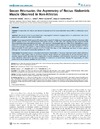Identificador persistente para citar o vincular este elemento:
https://accedacris.ulpgc.es/jspui/handle/10553/6564
| Título: | Soccer attenuates the asymmetry of rectus abdominis muscle observed in non-athletes | Autores/as: | Idoate, Fernando Calbet, Jose A.L. Izquierdo, Mikel Sanchis-Moysi, Joaquin |
Clasificación UNESCO: | 241106 Fisiología del ejercicio | Palabras clave: | Injury Sports Tennis MRI |
Fecha de publicación: | 2011 | Publicación seriada: | PLoS ONE | Resumen: | PURPOSE: To determine the volume and degree of asymmetry of the rectus abdominis muscle (RA) in professional soccer players. METHODS: The volume of the RA was determined using magnetic resonance imaging (MRI) in 15 professional male soccer players and 6 non-active male control subjects. RESULTS: Soccer players had 26% greater RA volume than controls (P<0.05), due to hypertrophy of both the dominant (28% greater volume, P<0.05) and non-dominant (25% greater volume, P<0.01) sides, after adjusting for age, length of the RA muscle and body mass index (BMI) as covariates. Total volume of the dominant side was similar to the contralateral in soccer players (P = 0.42) and in controls (P = 0.75) (Dominant/non-dominant = 0.99, in both groups). Segmental analysis showed a progressive increase in the degree of side-to-side asymmetry from the first lumbar disc to the pubic symphysis in soccer players (r = 0.80, P<0.05) and in controls (r = 0.75, P<0.05). The slope of the relationship was lower in soccer players, although this trend was not statistically significant (P = 0.14). CONCLUSIONS: Professional soccer is associated with marked hypertrophy of the rectus abdominis muscle, which achieves a volume that is 26% greater than in non-active controls. Soccer induces the hypertrophy of the non-dominant side in proximal regions and the dominant side in regions closer to pubic symphysis, which attenuates the pattern of asymmetry of rectus abdominis observed in non-active population. It remains to be determined whether the hypertrophy of rectus abdominis in soccer players modifies the risk of injury. | URI: | https://accedacris.ulpgc.es/handle/10553/6564 | ISSN: | 1932-6203 | DOI: | 10.1371/journal.pone.0019022 | Fuente: | PLoS ONE [ISSN 1932-6203 ], v. 6 (4), (e19022) |
| Colección: | Artículos |
Vista completa
Citas SCOPUSTM
16
actualizado el 08-jun-2025
Citas de WEB OF SCIENCETM
Citations
13
actualizado el 08-jun-2025
Visitas
276
actualizado el 13-dic-2025
Descargas
140
actualizado el 13-dic-2025
Google ScholarTM
Verifica
Altmetric
Comparte
Exporta metadatos
Este elemento está sujeto a una licencia Licencia Creative Commons

